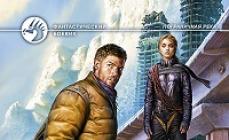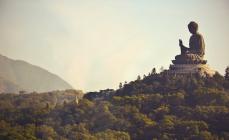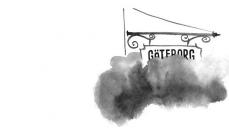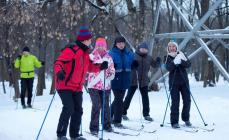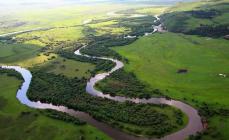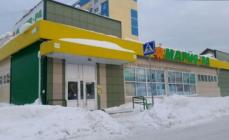Under the name "Vorobyovy Gory" is known the area located in the southwestern part of the Russian capital, which is a forested area on the high right bank of the Moscow River. Since 1988, by official decree, this area has become a nature reserve, which is under state protection.
In the ratings of the most attractive sights of Moscow, Sparrow Hills are regularly included in the top 10, and attract a huge mass of both Muscovites and guests of the capital. This is one of the most well-maintained park complexes in the Russian capital, on the territory of which various events are regularly held, including concerts, sports competitions and much more.
Sparrow Hills: Moscow's main pedestrian zone
Vorobyovy Gory is an area with huge ravines, a significant number of underground springs and ponds. Taking into account the peculiarities of the area, namely landslide processes, which have recently become more frequent, it is forbidden to travel by car and other vehicles, which have a significant mass.
Due to this, the territory of the nature reserve is considered one of the most environmentally friendly in the Russian capital. The territory of Sparrow Hills is extremely attractive for lovers walking tours and cycling. In addition, several areas for skaters and other amateurs are equipped on the hilly terrain. extreme species sports.
The pedestrian zone of the Sparrow Hills includes the nature reserve itself, the Krymskaya embankment, Boring Garden And central park named after Gorky. The total length of the zone is more than 10 km.
Given the rather significant length of the pedestrian zone, in the spring and summer, you can find a lot of bike rental points in the parks. Thanks to well-groomed and comfortable bike paths, Vorobyovy Gory is considered the center of cycling in Moscow.
On the outskirts of the park area, within the hilly area, there are several sites for lovers of extreme recreation. Skateboarders regularly gather here, and competitions of all-Russian significance are periodically held.
Especially popular is Observation deck on Sparrow Hills. It is situated on a hill which gives a considerable line of sight, and there is always a considerable number of visitors. According to many analysts, out of 10 foreigners who visit the Russian capital for tourism purposes, at least 8 visit the natural reserve and take pictures from the observation tower.

Ecological trails of Sparrow Hills
Sparrow Hills is considered one of the seven hills of Moscow, and this area is characterized by good environmental conditions and attractive landscapes. Taking into account the fact that this area is a park, significant areas here are occupied by green plantations, mainly related to broad-leaved forest cover.
For lovers of green tourism in the park is provided additional service such as walking along ecological trails. There are several such zones in the forest belt. They pass through the entire territory of the Sparrow Hills, and are very popular due to the interesting landscapes.
The key ecological trail starts from the Vorobyovskaya embankment. It passes through the most attractive places of the reserve. Using the service of walking along this trail, each person can not only enjoy the fresh air, birdsong and magnificent landscapes, but also be able to feel unity with nature. Since traffic in this region is limited, road noise is practically not felt here.
There are several ponds in the area of the ecological trail. Here you can rest, sitting in shady gazebos, or admiring the magnificent lawns with green grass. At one time, the possibility of arranging a beach recreation area near one of the reservoirs was discussed, but later this idea was abandoned.
Sparrow Hills are considered a real hotbed of lilacs of different varieties. A huge number of ornamental shrubs are planted along the walking paths, and therefore, during the period when the lilac begins to bloom, there are especially many visitors here.
One of the ecological routes is a walk along the Moscow River. On the territory of the reserve there is a pier from which pleasure boats and yachts depart regularly. So, if you want to get to know Moscow better, you should take advantage of this offer.

Infrastructure support of Sparrow Hills
Considering the fact that Sparrow Hills has long been the most important vacation spot for Muscovites and guests of the capital, the infrastructure here is very good.
Getting to the park area is very easy. It is enough to get to Moscow State University or to Vernadsky Avenue, as you find yourself in a completely different environment, filled with peace and quiet, as well as the peace of wildlife.
Within the waterfront, you can buy souvenirs, visit the toilet, or rent roller skates and a bicycle. It is worth noting for motorists that the car will have to be left in one of the parking lots located at least 100 meters from the park area.
If as a result of the walk you get hungry and want to have a bite, then you will need to visit the observation deck. There are several cafes and restaurants with quite delicious cuisine. There is also a mini-hotel with comfortable rooms.
There are several points of medical assistance on the territory of the park zone. In addition, several stages have been set up in Vorobyovy Gory, where open concerts. In the summer, there are especially many concerts and other performances that attract Muscovites.
To walk around nature reserve, it is not at all necessary to travel outside Moscow. In the city limits of the capital there is a natural reserve "Vorobyovy Gory", formed in 1998 in order to preserve the natural historical and cultural complexes and landscapes of Moscow. The 137.5-hectare reserve is home to many endangered plant, animal, bird or insect species.
Eco-trails are laid throughout the reserve, along which you can walk on your own or with a guided tour. As sightseeing tour there are several scenic routes to choose from: “On the slopes Sparrow Hills”, “Andreevsky Ponds”, “On the terraces of the Sparrow Hills”. In addition, guests of the reserve can choose one of the thematic excursions: "Literary Sparrow Hills", "Wintering Birds of Moscow", "Biodiversity", "Sparrow Hills Spring Flora" and others. If you wish, you can end the walk with a picnic - there are places for grilling shish kebabs near Andreevsky Ponds, and cozy gazebos are located along the entire route.
The participants of the tour will pass by enclosures with rare ornamental birds (pheasants, peacocks, turkeys), squirrels, as well as birds of prey. Not far from the enclosures there is an observation deck with great view on the slopes of Sparrow Hills. Interest in children will surely be aroused by the alley of birds with feeders, birdhouses and titmouses. Playgrounds can also be found on the territory of the reserve.
Free tours are held on weekdays from 8.00 to 17.00. You can also go for a walk on weekends. separate fee. There is no specific time for the start of excursions, it is recommended to sign up in advance. If you wish, you can come with children or with the whole class. The duration of the excursions is from 40 minutes to two hours, depending on the weather and the age of the participants.
If you wish, you can take part in an ecological quest in the Vorobyovy Gory nature reserve and spend time interestingly doing logical tasks, orienteering and photography.
Bicycles for rent
On Sparrow Hills there are many places where it will be interesting to ride a bike. For those who want to rent a bike, there are several rental points in different areas of the park.
Parents with children can ride a bike for free - a free rental point for children's and adult bicycles has been opened in the Pioneer Palace. In addition to bicycles, there are scooters and balance bikes, roller skates for children and adults, you can rent a protection kit, Nordic walking sticks, ping-pong and badminton sets. The rental office is open in the second building of the Palace on weekdays from 15.00 to 20.00, on weekends from 12.00 to 20.00. You will need a passport to rent.
Another rental point operates in the Main building of Moscow State University. There are sports and road bikes of the brands Sprint, Atom, Upland, Legend. This rental is paid, for 200 rubles. per hour you can take a new bike, last year's and worn-out models are given for 150 rubles per hour. You can rent a bicycle for a day (600-800 rubles), there are roller skates in the assortment. For a pledge, a document or 5000-10000 rubles is required. The rental office is open from 11.00 to 23.00, but before the visit, you should call the security of Moscow State University in order to freely enter the territory of the university.
Two more rental points are located on the embankment near the armchair and near the exit to Vorobyovskoye highway.
Natalia Reshetnikova
Tasks: Introduce children to the pond and its inhabitants: fish, frogs, insects, birds (wild ducks, herons, aquatic plants. Teach children to build food chains, establish simple cause-and-effect relationships, guess riddles. Show that they live on the shore and in the water those plants and animals that cannot do without water.To form an idea of autumn changes in living and non-living nature.Develop memory, thinking, visual perception, cognitive interest.Develop a good attitude towards all living things, strive to preserve the nature of the native land.
Preliminary work:
Looking at illustrations and pictures.
Conversations with children about the aquatic environment.
Reading educational literature.
Equipment: chalk, heron hats for the game "Herons and Frogs", a scarf for the game "Water",
Methodical methods:
1. Reminder of the rules of conduct and their justification.
2. Riddles about animals, insects and plants of the reservoir
3. Solving a cognitive problem: why do birds living near water bodies (herons, wild geese and ducks) fly away to warmer climes in autumn?
4. Reading fairy tales, stories, poems on this topic.
5. Drawing up a card file of riddles and sayings about the river, reservoir.
6. Summarizing conversation "How does the pond live?"
Movements:
Walking with wide and small steps in different directions, backwards, side steps, footprints, running at different paces, jumping on two legs, in place, moving forward, jumping
Progress of the walk
During the hike to the station "Water", are used different kinds walking and building.
Children come to a dry pond created on the ecological path of the kindergarten.
Educator: Children, let's remember what is the name of the reservoir created by man? That's right, a pond. Our small pond is a "home" in which both plants and animals live "friendly".
Every house has an owner. Our pond also has a water owner. He makes sure that no one offends the inhabitants of the pond and that everyone follows the rules of behavior near the pond. Let's remember these rules. What happens if you don't follow them? (children's answers).
Of course, the inhabitants of the reservoir may die, but we will not allow this.


Many aquatic inhabitants have already noticed our reservoir and settled in it. I will guess riddles, and you will guess them, and then we will remember who lives in the pond.
Shines in the clean river
The back is silver. (fish)
Right. How many fish are in our pond? (2) What do fish eat?
Along the river, along the water
A string of boats floats.
The ship is sailing ahead
He leads everyone.
Small boats have no oars,
And the boat hurts a walker.
Left, turn right
He will lead the whole gang. (duck with ducklings)
Bathed in the water
Stayed dry. (goose)
That's right, wild ducks and geese settled in our pond. They are very good at swimming because they have membranes on their paws. These birds are called "waterfowl". What do you think they eat? (algae, fish)
Standing on one leg
Looks very important.
Looks sharply at the water
So the frogs are guarded (heron)
In the summer in the pond and in the swamp
You will find it.
Green wah-
This is of course (frog)
Frogs live both in water and on land, which is why they are called amphibians. In the spring, like all animals, they give birth. Frogs lay their eggs in the water. Tailed tadpoles emerge from the eggs. The children look at the cards. Gradually, the tadpoles will grow legs, and the tail will fall off. And in a few months, the little frogs will come out of the water (jump out).
What do you think frogs eat? (mosquitoes, flies, grasshoppers, worms)
What plants grow in and around the pond? (Cattail or we call reeds, sedges, there are water lilies, duckweed, algae on the water in summer).


Animals, fish, insects live near the pond and in the pond, which have adapted to such a life that they cannot live without water and without each other. Fish feed on worms and algae. Ducks, geese catch fish. Frogs eat mosquitoes and slugs. They also cannot be in direct sunlight, they prefer shade from bushes and trees. Herons feed on frogs. Everything in nature is interconnected. If you kill all the mosquitoes, the frogs will die. If you cut down all the trees and bushes, the pond will dry up. Therefore, you can not kill frogs, catch all the fish in the pond and shoot ducks and geese.
What season is it now? What changes have taken place compared to the summer at the pond? The plants withered, the wind plucks the last leaves from the branches of the trees and from the bushes. Everything falls asleep until spring. In the autumn, the fish go deep into the algae in the pond. Do you know where frogs go in winter?
Lera and Makar will tell us about this now.
When I come to the pond in winter
I won't find frogs there
They fly away for the winter
South? Or maybe they float away?
Only the water gets colder
Frog - dive to the bottom of the pond
Hastens to bury himself in the mud,
To sleep soundly there until spring.
Water warms up in spring
They will all wake up then
When you come to the pond in spring
You will find those who sing them in the pond.
A thin ice will soon appear on the water. Guys, what do you think herons, wild ducks and geese will eat when the pond is covered with ice? That's right, these birds will fly away to warmer climes, because in winter they will not be able to find food here.
In the meantime, the frogs have not yet fallen asleep and the herons have not flown away, let's show how the herons catch the frogs.
Game "Herons and Frogs"
A large circle (pond) is drawn in the middle of the playground. With the help of a counting rhyme, two herons are chosen. Herons take place on opposite sides of the "pond". The rest of the children are frogs. They jump on two legs all over the site and say:
We are green frogs
We have fun on the edge,
Here we have a pond nearby -
The herons won't find us in it.
After the words “they won’t find it”, the “frogs” jump into the pond, and the “herons” try to stain them.
Reflection
- Who lives on the shore of the pond, and who lives in the water?
– Can they live in other places? For example, in the desert or in the forest?
How are lake dwellers related to each other? (Plants are food and home for animals, some animals eat others, etc.)
- What will happen in the lake if plants, insects, frogs, other inhabitants disappear?
What will happen if people start throwing garbage into this lake? Wash cars in it? Wash clothes? Will its inhabitants like it? What will they do?
Guys, the owner of our water pond is very pleased that we know a lot about his pond and take care of it, and for this he wants to thank you, to play with you.
Water game.
The driver sits in a circle with eyes closed. The players move in a circle with the words:
water, water,
Why are you sitting underwater?
Look out for a glimpse
For one minute.
After these words, the children scatter, the "water" catches them.
And now we'll go to kindergarten. Look around, think about what you will draw as a memory of our excursion. (I listen to the answers of the children). Who liked our tour - clap your hands, who did not like it - stomp your feet.


Related publications:
Excursion to the water! On the way to the pond, the teacher draws the attention of the children to the weather: “Look, what a good day it is today. Sun.
Today our children traveled along the ecological trail. We want everyone who passes through it to have a stronger desire to protect and.
Mushrooms are amazing plants, a gift product of nature. We do not sow them, we do not plant them, in the same place where we cut mushrooms today, we get them again.
Purpose, tasks: training the ability to use natural material in work; the formation of the ability to experiment with artistic materials;

